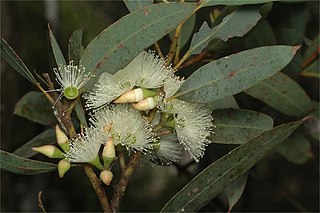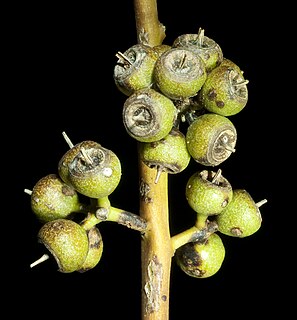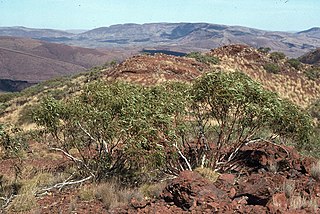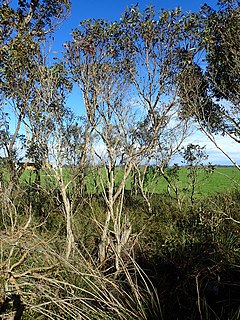
Eucalyptus lansdowneana, commonly known as the crimson mallee or the red-flowered mallee box, is a species of slender stemmed, straggly mallee that is endemic to a restricted area of South Australia. It has rough, fibrous or flaky bark at the base, smooth, grey over creamy-white bark, lance-shaped adult leaves, flower buds in groups of seven, crimson flowers and barrel-shaped fruit.

Eucalyptus effusa, commonly known as rough-barked gimlet, is a species of mallee or small tree that is endemic to Western Australia. It has thin, rough bark on the base of the trunk, smooth bark above, linear to narrow lance-shaped adult leaves, flower buds arranged in groups of seven, white flowers and cup-shaped to conical fruit.

Eucalyptus gittinsii, commonly known as northern sandplain mallee, is a species of mallee that is endemic to Western Australia. It has smooth greyish bark, sometimes with rough flaky bark near the base, lance-shaped to curved adult leaves, flower buds in groups of three, whitish flowers and cylindrical to barrel-shaped fruit.
Eucalyptus gypsophila, also known as the kopi mallee, is a species of mallee that is native to Western Australia and South Australia. It has rough, flaky bark on the lower part of the trunk, smooth light grey bark above, lance-shaped adult leaves, flower buds mostly in groups of between seven and eleven, creamy white flowers and conical to cylindrical fruit.

Eucalyptus insularis, commonly known as Twin Peak Island mallee, or North Twin Peak Island mallee, is a species of mallee that is endemic to a small area of southern Western Australia. It has mostly smooth bark, dull green, linear adult leaves, flower buds in group of between nine and twenty or more, white flowers and barrel-shaped fruit.

Eucalyptus ligulata, commonly known as Lucky Bay mallee, is a mallee that is native to a few small areas along the south coast of Western Australia. It has smooth bark on the trunk and branches, narrow lance-shaped leaves, flower buds in groups of between nine and thirteen, creamy white flowers and cup-shaped or barrel-shaped fruit with shallow ribs on the sides.
Eucalyptus litorea, commonly known as saline mallee, is a species of mallee that is endemic to a small area on the southern coast of Western Australia. It has hard, rough grey bark on the trunk, smooth grey bark above, lance-shaped adult leaves, flower buds in groups of seven, white flowers and cylindrical or barrel-shaped fruit.

Eucalyptus petrensis, commonly known as limestone mallee, straggly mallee or koodjat, is a species of straggly mallee that is endemic to Western Australia. It has mostly smooth bark, lance-shaped adult leaves, flower buds in groups of between seven and thirteen, creamy white flowers and more or less spherical fruit.

Eucalyptus pilbarensis is a species of mallee or low shrub that is endemic to the Pilbara region of Western Australia. It has smooth, white or greyish bark, lance-shaped to curved adult leaves, flower buds in groups of seven, white flowers and conical, barrel-shaped or cylindrical fruit.
Eucalyptus repullulans, commonly known as chrysoprase mallee, is a species of mallee that is native to arid parts of Western Australia and the far north-west of South Australia. It has smooth bark, lance-shaped adult leaves, flower buds in groups of between seven and thirteen, cream-coloured flowers and cup-shaped, cylindrical or conical fruit.

Eucalyptus extrica, commonly known as eastern tallerack, is a species of mallee that is endemic to Western Australia. It has smooth bark, lance-shaped adult leaves arranged in opposite pairs, flower buds in groups of three, whitish flowers and cylindrical to barrel-shaped fruit.

Eucalyptus alatissima is a mallee that is endemic to central parts of the Great Victoria Desert. It has rough bark on the lower part of its stems, smooth tan to cream-coloured bark on its upper parts, egg-shaped to lance-shaped leaves and buds in groups of three. The buds have a powdery covering and are prominently winged.

Eucalyptus adesmophloia is a mallee that is endemic to the south-west of Western Australia. Its fresh bark is grey, the leaves are a glossy dark green, the flowers are white and borne in large groups, and the fruits are conical to hemispherical.

Eucalyptus armillata, commonly known as red-flowered mallee, is a mallee that is endemic to the south-west of Western Australia. It has smooth bark, narrow lance-shaped adult leaves, flower buds hanging downwards in groups of three, usually red flowers and prominently ribbed fruit with a double flange around the rim.

Eucalyptus canescens, commonly known as the Ooldea Range mallee or Beadell's mallee, depending on subspecies, is a species of mallee that is endemic to southern Australia. It has rough bark from the base of the trunk to the thicker branches, smooth bark on the thin branches, egg-shaped to lance-shaped adult leaves, flower buds in groups of between seven and eleven, creamy white flowers and smooth cup-shaped to conical, and sometimes ribbed fruit.
Eucalyptus ecostata, commonly known as coastal silver mallee, is a species of mallee that is endemic to the south coast of Western Australia. It has smooth greyish bark, lance-shaped to curved adult leaves, flower buds in groups of between eleven and fifteen, creamy white flowers and more or less hemispherical but flattened fruit.
Eucalyptus opimiflora, commonly known as northern silver mallee, is a species of mallee that is endemic to near-coastal areas of Western Australia between Perth and Geraldton. It has smooth grey bark, lance-shaped adult leaves, flower buds in groups of between seven and fifteen, creamy white flowers and conical to hemispherical fruit.
Eucalyptus proxima, commonly known as nodding mallee or red-flowered mallee, is a species of mallee that is endemic to a small area in the south-west of Western Australia. It has smooth greyish bark, lance-shaped adult leaves, flower buds in groups of seven, red to pink, sometimes yellowish flowers and conical to slightly bell-shaped fruit.
Eucalyptus rowleyi is a species of mallee that is endemic to the Pilbara region of Western Australia. It has smooth grey bark, lance-shaped adult leaves, flower buds in groups of seven or nine, white flowers and cylindrical to urn-shaped fruit.
Eucalyptus vittata is a species of mallet that is endemic to Western Australia. It has smooth bark, lance-shaped adult leaves, ribbed flower buds in groups of seven or nine, creamy white flowers and glaucous, hemispherical to cylindrical or cup-shaped fruit.












